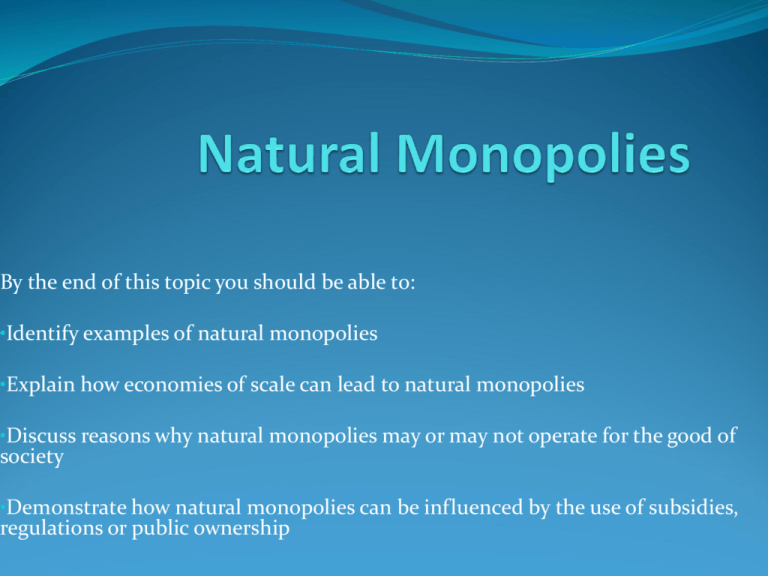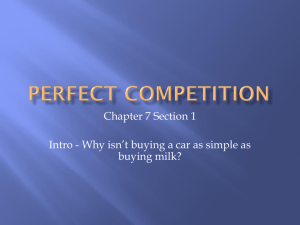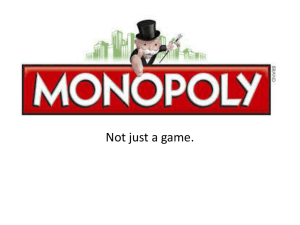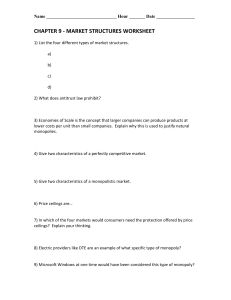Natural Monopolies
advertisement

By the end of this topic you should be able to: •Identify examples of natural monopolies •Explain how economies of scale can lead to natural monopolies •Discuss reasons why natural monopolies may or may not operate for the good of society •Demonstrate how natural monopolies can be influenced by the use of subsidies, regulations or public ownership Types of monopolies Pure Monopoly One firm dominates the market and can maintain this because of high barriers to entry Natural Monopoly One firm is able to supply the entire market at a lower cost than two or more firms Natural Monopoly Has the same characteristics as a pure monopoly and a main distinguishing feature Its average cost curves are downwards sloping over the whole output due to economies of scale. Examples – town infrastructure Distribution of electricity Railways Pipelines Fixed-line telephone networks Economies of Scale and Natural Monopolies Economies of scale occur because of two factors High fixed costs Costs involved in setting up the business Low marginal costs Cost of adding new consumers to the network is low As output increases, the AC curve falls as greater economies of scale are achieved. Cost Curves for a Natural Monoply Cost Curves for a Pure Monopoly MC p q AC Q The average cost curve begins to rise after it cuts the MC curve. Natural Monopolies Society benefits from allowing the natural monopoly to occur. As it can increase output and allow prices to be lower due to economies of scale. It would not be efficient to encourage competition as it would mean creating duplicate networks that could not gain economies of scale. Networks Most monopolies occur in networks, commonly the infrastructure of towns. E.G.Distribution of water, waste gas, telecommunications, electricity, roading and postal services. Networks are expensive to set up but gain economies of scale as output increases Producer Consumer Q TC AC 1 100 100 2 100 50 Q TC AC 1 100 100 2 100 50 50 100 2 The need for intervention The natural monopolist will aim to maximise its profits and will do this by restricting output to charge a higher price. (Profit max level MC=MR) The firm will then not gain the potential economies of scale and there will be a loss of allocative efficiency. Intervention Two types Public ownership (Government owning the natural monopoly ) Regulations ( price controls) Public Ownership and Natural Monopoly – notes The government taking over the ownership of an industry = Nationalisation Under public ownership the government could operate the monopoly At an allocatively efficient level of output Charge a price equal to marginal cost Cover any losses out of tax revenues NZ history of govt ownership 1930s, a lot of NZ firms were nationalised. The govt identified strategic businesses they felt had to be kept going. Example: NZ rail, postal services, telecommunications, broadcasting, electrical power and many other services have been run by the state. In the 1980s and 1990s during the reforms, monopolies were deregulated and turned into State Owned Enterprises and some were sold to the private sector called privatisation Regulatory Pricing for a Natural Monopolist A private owned natural monopoly can be regulated to produce at a more socially desirable level of output in order to increase allocative efficiency. Regulatory pricing can be set at the following levels Marginal cost pricing ( where price =MC) Average cost pricing (where price = AC in order to provide a normal profit ) Marginal Cost Pricing This is where allocative efficiency will be achieved. Revenue and costs Price and Quantity before regulation Ppm & Qpm. Ppm AC MC Pmc AR Qpm Qmc MR Govt imposes a maximum price of Pmc resulting in an output of Qmc where P=mc This will result in subnormal profits Output (millions) Subnormal Profits To make sure the business continues operating in the long run, this subnormal profit can be paid for in two ways 1. 2. Amount of loss can be matched by a subsidy payment from the govt The monopolist could charge a two part tariff. Amount of loss can be paid for from a daily charge or line rental paid by consumers MC can be the user charge, per unit consumed. Average Cost Pricing It is difficult to determine where AC is. It involves finding the value of normal profits. Revenue and costs Setting P=AC Consumers will be able to pay a lower price. DWL Pac AC MC AR Qac MR Output (millions) This type of regulation does not require any remedial action by the govt in the form of a subsidy. Issues for Natural Monopolies Some times monopolies can be split up into different elements. Natural monopoly elements have been isolated from more competitive elements. The competitive elements of the industry can be allowed to operate in a competitive market. Example NZ electricity. Electricity generation split from line-transmission and retail activities. Issues for Natural Monopolies Bundling. Using a monopoly in one product to create a monopoly in another product. Telecom has a monopoly in handling local calls through the copper wire network of phone lines. This network also is the main platform for carrying broadband internet – also monopolised.








